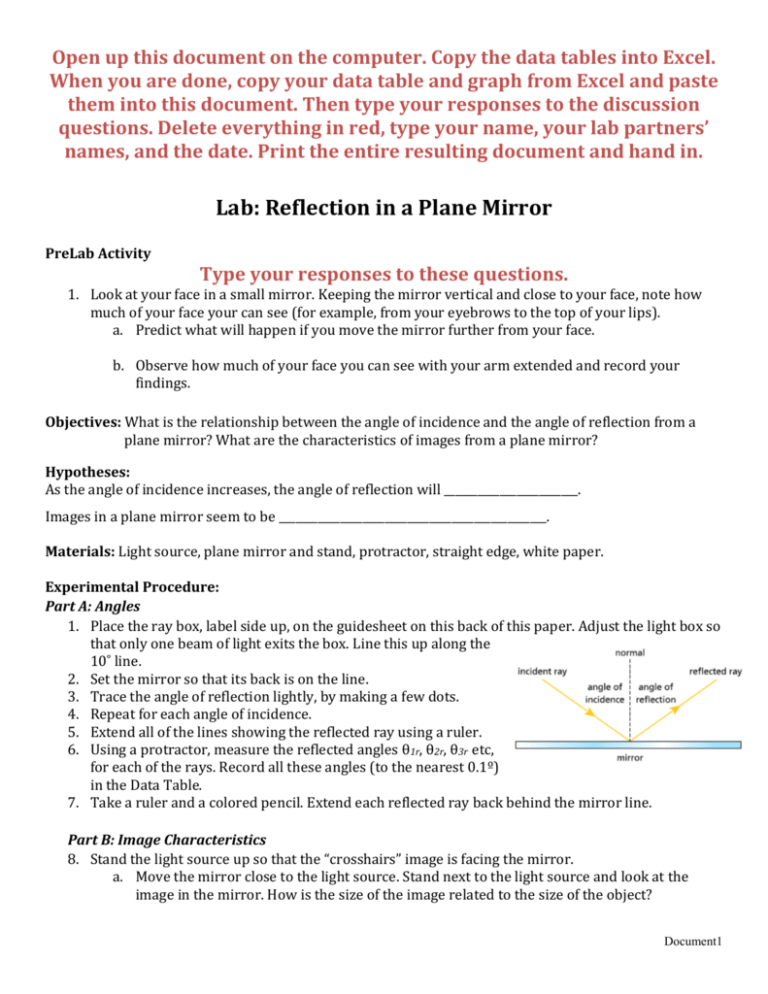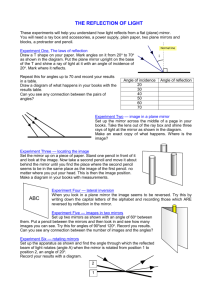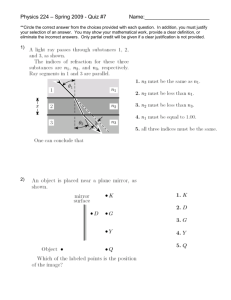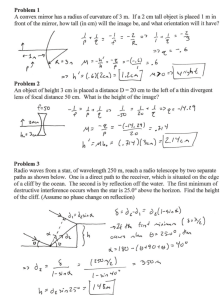Discussion Questions
advertisement

Open up this document on the computer. Copy the data tables into Excel. When you are done, copy your data table and graph from Excel and paste them into this document. Then type your responses to the discussion questions. Delete everything in red, type your name, your lab partners’ names, and the date. Print the entire resulting document and hand in. Lab: Reflection in a Plane Mirror PreLab Activity Type your responses to these questions. 1. Look at your face in a small mirror. Keeping the mirror vertical and close to your face, note how much of your face your can see (for example, from your eyebrows to the top of your lips). a. Predict what will happen if you move the mirror further from your face. b. Observe how much of your face you can see with your arm extended and record your findings. Objectives: What is the relationship between the angle of incidence and the angle of reflection from a plane mirror? What are the characteristics of images from a plane mirror? Hypotheses: As the angle of incidence increases, the angle of reflection will ________________________. Images in a plane mirror seem to be ________________________________________________. Materials: Light source, plane mirror and stand, protractor, straight edge, white paper. Experimental Procedure: Part A: Angles 1. Place the ray box, label side up, on the guidesheet on this back of this paper. Adjust the light box so that only one beam of light exits the box. Line this up along the 10˚ line. 2. Set the mirror so that its back is on the line. 3. Trace the angle of reflection lightly, by making a few dots. 4. Repeat for each angle of incidence. 5. Extend all of the lines showing the reflected ray using a ruler. 6. Using a protractor, measure the reflected angles θ1r, θ2r, θ3r etc, for each of the rays. Record all these angles (to the nearest 0.1º) in the Data Table. 7. Take a ruler and a colored pencil. Extend each reflected ray back behind the mirror line. Part B: Image Characteristics 8. Stand the light source up so that the “crosshairs” image is facing the mirror. a. Move the mirror close to the light source. Stand next to the light source and look at the image in the mirror. How is the size of the image related to the size of the object? Document1 b. Move the mirror further from the light source. Stand next to the light source and look at the image in the mirror. How is the size of the image related to the size of the object? 9. Turn over the ray diagram to show the paper. Set up the red transparent plastic on the line. Print your name in large block capital letters along the normal (the line perpendicular to the mirror). Observe the reflection of your name as reflected in the plastic. a. How can you explain the reflection you see? b. Which letters in the image are closest to the mirror? Which are farthest away? c. Without moving your head or the paper, put your hand behind the plastic and trace the reflected image. d. Remove the plastic screen. Measure the distance of each letter to the mirror line, then measure the distance of its reflection and the mirror line. Record the data in Table 2. Is there a pattern? Normal Place reflector along this line 10. Carefully stand up two flat mirrors so they meet at a right angle. Be sure they touch each other, as shown. a. Place a bolt upright in front of the mirrors. b. How many images do you see? c. Slowly change the angle between the mirrors. Make a general statement about how the number of images you see changes as the angle between the mirrors changes. DATA AND OBSERVATIONS Data Table 1: Reflection at various angles Ray Angle of Incidence, 1 Angle of Reflection, 2 Difference in Angle Percent Error 1 2 3 4 5 6 7 Data Table 2: Reflection of your name Letter Distance from Letter Distance from Reflected to the mirror line. Letter to the mirror line. Attach your ray diagram & your name diagram. Document1 GRAPH: Make a graph of the angle of incidence vs. the angle of reflection. Paste the graph here. Calculations: Type your calculations by going to “Insert”, “Equation”. You only need one sample for each. 1) Calculate the difference (|θreflected– θincident|) between the measured values of the incident angle and the reflected angle for each of the three rays and record them in the Calculations Table. 2) Calculate the Percent Error between the Experimental Angle and the Theoretical Angle. Show a sample of this. Discussion Questions Type your responses in complete sentences! 1. Where is the image in a plane mirror located? 2. What is the slope of the line of your graph? What relationship does the graph show between the angles of incidence and reflection? 3. Since things far away appear smaller to your eyes, how does the position of the image appear to change as the object is moved away from the mirror? 4. How is the size of the image reflected in a plane mirror related to the size of the object? 5. How is the orientation of the image (right side up, upside down, flipped laterally &/or not changed) related to the orientation of the object? Before you print this document, proofread for spelling. Be sure you have deleted all type that is in RED, including these sentences. Insert page breaks to keep sections on the same page. Especially make sure that you do not split tables onto multiple pages. Document1 Normal to the Mirror line… Write your name in Block letters along this line Place reflector along this line Document1






